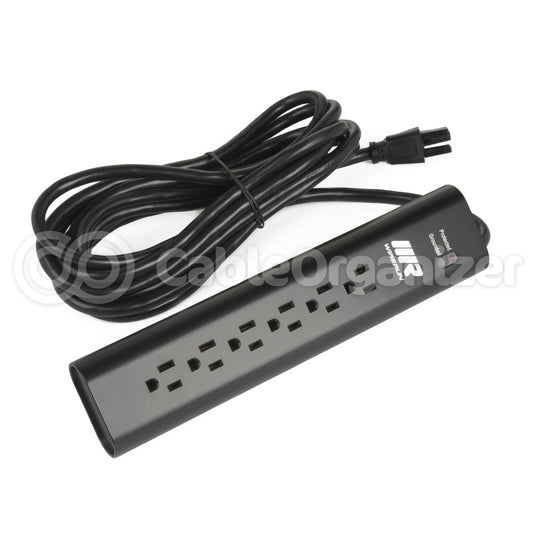Real, Reactive, & Apparent Power
By: CableOrganizer®
An intricate process takes place behind the scenes when turning on any electrical item. Electricity needs to be supplied to the grid and ultimately the component. Various power types contribute to the process, which we will explain in further detail within this article, including real power, reactive power, complex power and apparent power.
Real power is within an alternating current (AC) circuit and measured in watts. It handles the actual work within a circuit, providing electricity to every energized item. It is also known as “active power” because it is the type channeled through the grid before it provides power to items ranging from your phone to your lightbulbs.
Reactive power differs from real power. It does not directly electrify items, but still plays a role on the power grid, keeping electricity moving evenly between generators and capacitors (an electricity holding area). It is delivered into the system as needed to provide balance within voltage highs and lows. Consider an ideal AC circuit consisting of a source and a generalized load, where both the current and voltage are sinusoidal. If the load is purely resistive, the two quantities reverse their polarity at the same time, the direction of energy flow does not reverse — and only real power flows. If the load is purely reactive, then the voltage and current are 90 degrees out of phase and there is no net power flow. This energy flowing backward and forward is known as reactive power. If a capacitor and an inductor are placed in parallel, then the currents flowing through the inductor and the capacitor oppose and tend to cancel out rather than adding. Conventionally, capacitors are considered to generate reactive power and inductors to consume it. This is the fundamental mechanism for controlling the power factor in electric power transmission; capacitors (or inductors) are inserted in a circuit to partially cancel reactive power of the load. A practical load will have resistive, inductive and capacitive parts — and so both real and reactive power will flow to the load.
Complex power is the sum of real power and reactive power. Apparent power is the vector sum of real and reactive power. It represents two types of power — the real type that has been sent out to power up items and the reactive one that remains within the AC circuit. The apparent power is the Root Mean Square (RMS or rms) of voltage and current. Apparent power is handy for sizing of equipment or wiring. However, adding the apparent power for two loads will not accurately give the total apparent power unless they have the same displacement between current and voltage.
Engineers use the following terms to describe energy flow in a system (and assign each of them a different unit):
- Real Power (P) [Unit: W]
- Reactive Power (Q) [Unit: VAR]
- Complex Power (S): The complex value S is referred to as the complex power.
- Apparent Power (|S|) [Unit: VA]: it is the absolute value of Complex Power S.
In the diagram, P is the real power, Q is the reactive power (in this case negative), S is the complex power; and the length of S is the apparent power.

The unit for all forms of power is the watt (symbol: W). However, this unit is generally reserved for the real power component. Apparent power is conventionally expressed in volt-amperes (VA) since it is the simple product of rms voltage and rms current. The unit for reactive power is given the special abbreviation "VAR," which stands for volt-amperes reactive (since reactive power flow transfers no net energy to the load, it is sometimes called "wattless" power). Note that it does not make sense to assign a single unit to complex power because it is a complex number; and it is therefore defined as a pair of two units: W and VAR.
Understanding the relationship between these three quantities lies at the heart of understanding power engineering. The mathematical relationship among them can be represented by vectors or expressed using complex numbers, (where j is the imaginary unit).
POWER FACTOR:
Power factor measures the efficiency of an AC power system. Power factor is the real power per unit of apparent power. (pf = Wh/VAh) A power factor of one is perfect, and 99% is good. Where the waveforms are purely sinusoidal, the power factor is the cosine of the phase angle (f) between the current and voltage sinusoid waveforms. Equipment data sheets and nameplates often will abbreviate power factor as "cosf" for this reason. Power factor equals 1 when the voltage and current are in phase; and is zero when the current leads or lags the voltage by 90 degrees. Power factors are usually stated as "leading" or "lagging" to show the sign of the phase angle, where leading indicates a negative sign. For two systems transmitting the same amount of real power, the system with the lower power factor will have higher circulating currents. This is due to energy that returns to the source from energy storage in the load. These higher currents in a practical system will produce higher losses and reduce overall transmission efficiency. A lower power factor circuit will have a higher apparent power and losses for the same amount of real power transfer. Purely capacitive circuits cause reactive power with the current waveform leading the voltage wave by 90 degrees, while purely inductive circuits cause reactive power with the current waveform lagging the voltage waveform by 90 degrees. The result of this is that capacitive and inductive circuit elements tend to cancel each other out.
REACTIVE POWER FLOW:
In power transmission and distribution, significant effort is made to control the reactive power flow. This is typically done automatically by switching inductors or capacitor banks in and out, by adjusting generator excitation — and by other means. Electricity retailers may use electricity meters, which measure reactive power to financially penalize customers with low power factor loads. This is particularly relevant to customers operating highly inductive loads such as motors at water pumping stations.
INTELLIGENT BATTERY:
Output current depends upon the battery's state. An intelligent charger may monitor the battery's voltage, temperature and/or time under charge to determine the optimum charge current at that instant. Charging is terminated when a combination of the voltage, temperature and/or time indicates that the battery is fully charged.
For Ni-Cd and NiMH batteries, the voltage across the battery increases slowly during the charging process, until the battery is fully charged. After that, the voltage decreases, which indicates to an intelligent charger that the battery is fully charged. Such chargers are often labeled as a “V” or "delta-V," charger, indicating that they monitor the voltage change.
A typical intelligent charger rapidly charges a battery up to about 85% of its maximum capacity in less than an hour, then switches to trickle charging, which takes several hours to top off the battery to its full capacity.
VOLT-AMPERES:
A volt-ampere in electrical terms, means the amount of apparent power in an alternating current circuit equal to a current of one ampere at an emf of one volt. It is equivalent to watts for non-reactive circuits as follows:
- 10 kV·A = 10,000 watts capability (where the SI prefix k equals kilo)
- 10 MV·A = 10,000,000 watts capability (where M equals mega)
While the volt-ampere and the watt are dimensionally equivalent one may find products rated in both VAs and watts with different numbers. This is common practice on UPS (Uninterruptible Power Supply) systems. The VA rating is the apparent power that a UPS can produce, while the watt rating is the real power (or true power) it generates as opposed to reactive power. Reactive power arises because of capacitance and inductance of components in the load that is powered by the AC circuit. In a purely resistive load (incandescent lights for example), the apparent power is equal to the true power and the amount of VAs and watts used would be equivalent. However, in more complex loads, such as computers (which UPSs are intended to power) the apparent power used (VAs) will be larger than the true power used (watts). The ratio of these two quantities is called the power factor.
Shop at CableOrganizer® for electrical supplies, chargers, desk outlets, uninterruptible power supply (UPS) systems and much more.


